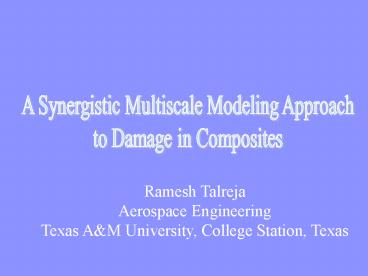A Synergistic Multiscale Modeling Approach PowerPoint PPT Presentation
1 / 37
Title: A Synergistic Multiscale Modeling Approach
1
A Synergistic Multiscale Modeling Approach to
Damage in Composites
Ramesh Talreja Aerospace Engineering Texas AM
University, College Station, Texas
2
Contents
- The Engineering Motivation
- Damage Scenarios
- Multiple Scales
- ? of heterogeneities
- ? of damage entities
- Hierarchical approach (up-the-scales)
- Motivated (need-based) treatment of scales
- Conclusion
3
(No Transcript)
4
(No Transcript)
5
(No Transcript)
6
Question What is the best sequence of modeling
Right to Left, Or Left to Right, Or Combined
(Synergistic)?
7
Damage classification Damage in
composites Multiple cracking where shear-lag
(at interfaces) is involved
- Pre-damage regime
- Damage regime
- Post-damage regime
- (Localization and fracture)
8
Pre-Damage Regime Example Unidirectional
Composite in Transverse Tension
s
Debonding induces matrix cracking
Matrix cracking causes debonding
s
Length scales of microstructure Fiber diameter,
Inter-fiber spacing
9
Local Stress State resulting from transverse
loading of fiber composites
s
Dilatational
- Depends on
- Fiber and matrix properties
- Fiber distribution
s
Distortional
10
Effect of Dilatational (hydrostatic tension)
stress
Cavitation, presumably from free volume
in polymers
Unstable growth of cavitation at critical
dilatational energy
11
Effect of Dilatational (hydrostatic tension)
stress
s
When dilatational energy reaches a critical
value, cavities burst open causing debonding
Length scales of damage Cavity diameter (before
debonding) Fiber diameter (after debonding)
s
Asp, Berglund, Talreja (1996)
12
Effect of Distortional stress
s
Distortional
Matrix cracks form by Yielding, Void growth
and Coalescence, crazing
Length scales of damage Cavity diameter (before
cracking) Inter-fiber spacing (after cracking)
Models Rice, Tracey (1969) Boyce, Parks, Argon
(1988) Gearing, Anand (2004)
s
13
Polymer Fracture Through Crazing
A
B
C
E
D
14
Damage Regime Example 1 Unidirectional Ceramic
Matrix Composite in Tension
Fiber-bridged matrix crack
Fibers
Increasing load
15
Damage Regime Example 2 Cross-Ply Polymer
Matrix Composite in Fatigue
Transverse cracks
Delaminations
Axial splits
16
Cross Ply Composites and Woven Fabric Composites
17
Damage Regime Example 3 General laminate with
off-axis ply cracking
18
Damage in Composites
- Multiple matrix cracks, interfacial disbonds,
delaminations, fiber breaks, microbuckled fibers,
and more - Multiple orientations
- Multiple scales of damage entities
- Multiple rates of evolution
- Multiple effects on material response
19
The Multi-Scale Nature ofDamage in Composites
- What is the Lowest Damage Scale?
- A Purist (Scientific) View
- The first (basic) scale at which dissipative
mechanism(s) occur. - A Pragmatist (Engineering) View
- The first significant scale (manifesting behavior
of lower scales, if any) that governs the
property of interest. Preferably, scale of
observable entities.
20
The Choice of Scales in an Engineering Approach
- Should be guided by the purpose (Model)
- -- To predict properties and performance, or
- -- To design properties for selected
performance - Should account for the scale of inhomogeneities
- (fibers, particles, plies, etc.)
- -- Damage entities are often initiated by
- inhomogeneities, and evolve under their
influence
21
Damage Mechanisms Unidirectional Ceramic Matrix
Composite in Tension
Increasing Load Increasing Crack Density
22
Stress-Strain Response Unidirectional Ceramic
Matrix Composite in Tension
23
Stage II Damage Mechanism
sliding
debonding
Fiber-bridged Matrix Cracking
24
Length Scales of Stage II Damage Mechanism
Damage Entity Length Scale Crack length RVE
Length Scale Crack spacing Microstructural
Length Scale Fiber diameter
25
Damage Mechanisms Cross-Ply Polymer Matrix
Composite in Fatigue
Delaminations
Multiple Damage Modes Transverse Ply
Cracks Axial Splits
26
Length Scales - Ply Cracking in Laminates
Damage Entity Length Scale Ply thickness,
tc RVE Length Scale Crack spacing,
s Microstructural Length Scale Ply thickness, t0
27
Ply Cracking with Delamination
Damage Entity Length Scale Ply thickness,
tc RVE Length Scale Crack spacing,
s Microstructural Length Scale Ply thickness, t0
28
A Continuum Characterization of Damage
29
(No Transcript)
30
(No Transcript)
31
A Tensorial Representation of Damage
RVE
ni Unit normal to damage entity surface ai
Represents pre-specified influence of damage
entity on the surrounding medium
32
(No Transcript)
33
- The damage tensor for intralaminar-cracking is
given as follows
tc Thickness of the cracked ply tT Total
laminate thickness s1 Spacing between cracks ?
Effect of constraint on the crack opening
displacement imposed by the uncracked laminae
34
The Internal Variable of Damage
- All terms are measurable, except ?
- ? depends on microstructure and its
- length scales, and can be experimentally
- identified or calculated by analytical
- or computational micromechanics
35
?
36
Examples of SDM
- Multiple cracking in UD CMC (Sørensen,Talreja,
1993) - Multiple ply cracking in cross ply laminates
(Varna, Akshantala, Talreja , 1999) - Multiple transverse cracking with varying
constraints (Varna, Akshantala, Talreja, 1999
Varna, Joffe, Talreja, 2001) - Linear viscoelastic cross ply laminates with
transverse cracks (Kumar, Talreja, 2003 Varna,
Krasnikovs, Kumar, Talreja, 2004) - Off-axis multiple cracking one mode (Varna,
Joffe, Akshantala, Talreja, 1999 Singh, Talreja,
2008) - Off-axis multiple cracking two modes (Singh,
Talreja, 2009)
- Review papers
- Talreja, R., Journal of Materials Science, 2006
- Talreja, R. and Singh, C.V., In Multiscale
Modeling - and Simulation of Composite Materials and
Structures, - Y. Kwon, D.H. Allen and R. Talreja, Eds., Chapter
12, Springer, 2007.
37
Conclusion
- Damage in composite materials is complex
(multitude of size, shape, orientation) and not
suited for up-the scale multi-scale approach - For application to complex shaped structures in
service loading (time-varying multiaxial stress,
temperature) continuum damage mechanics is the
most suitable approach - Synergistic approach (CDM with access to
judiciously selected micromechanics results) has
been demonstrated for elastic and linear
viscoelastic composites. - Damage evolution, not discussed here, is treated
by micromechanics

